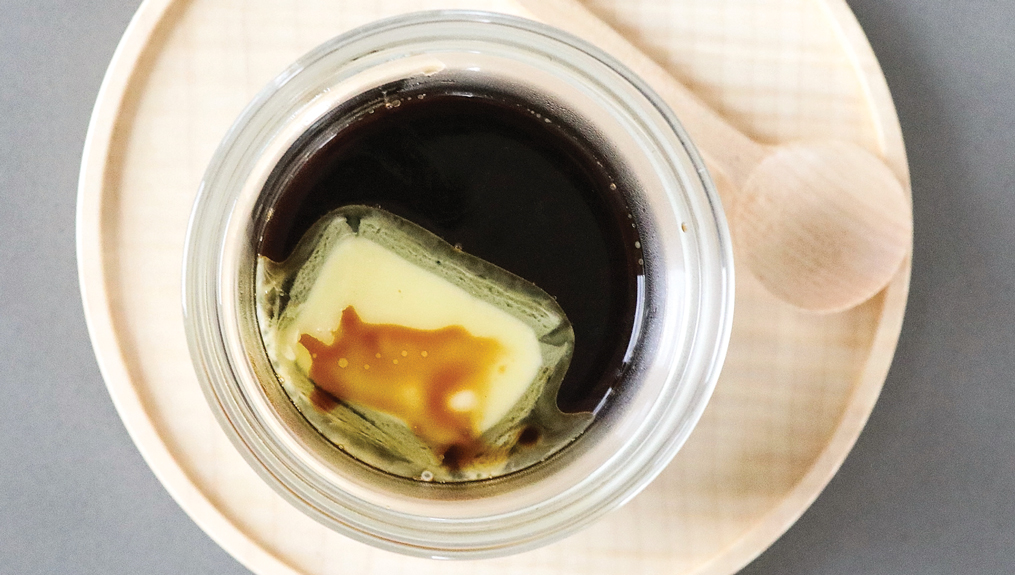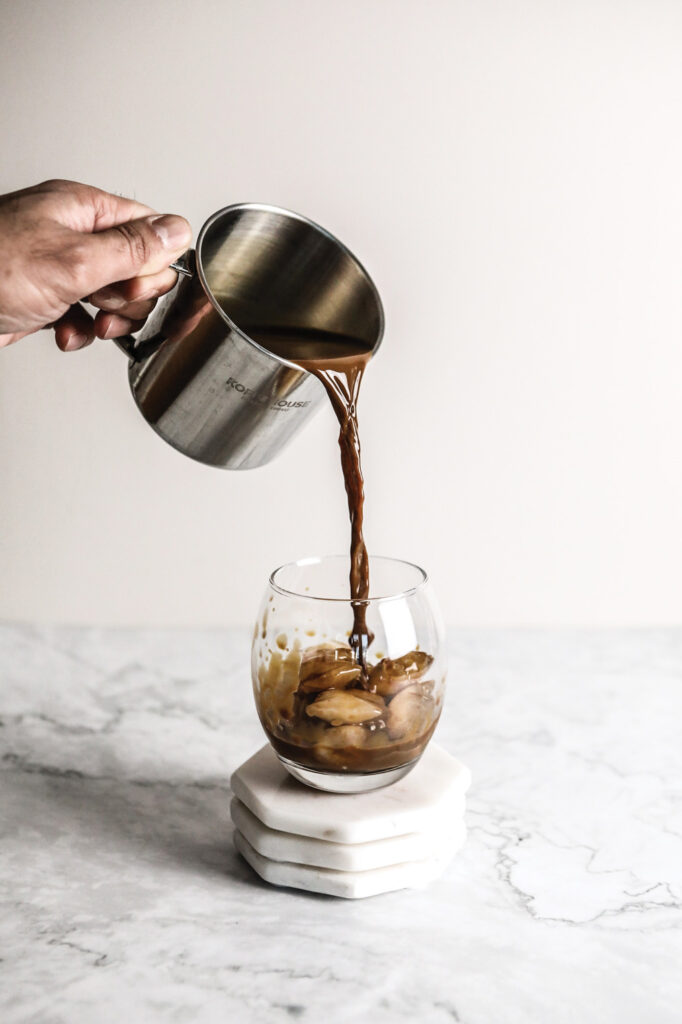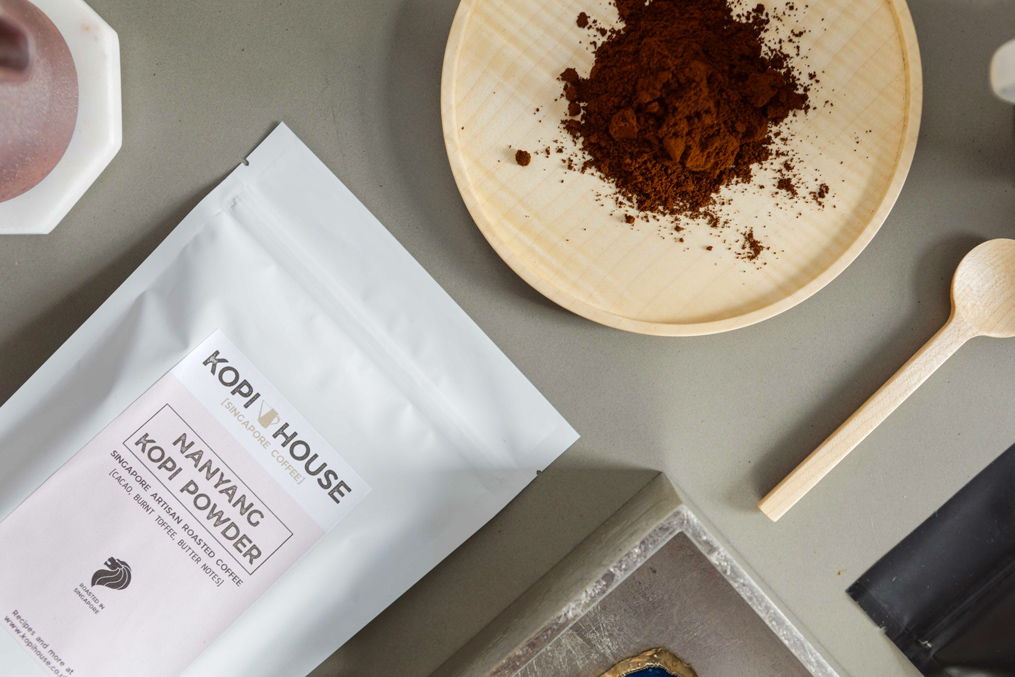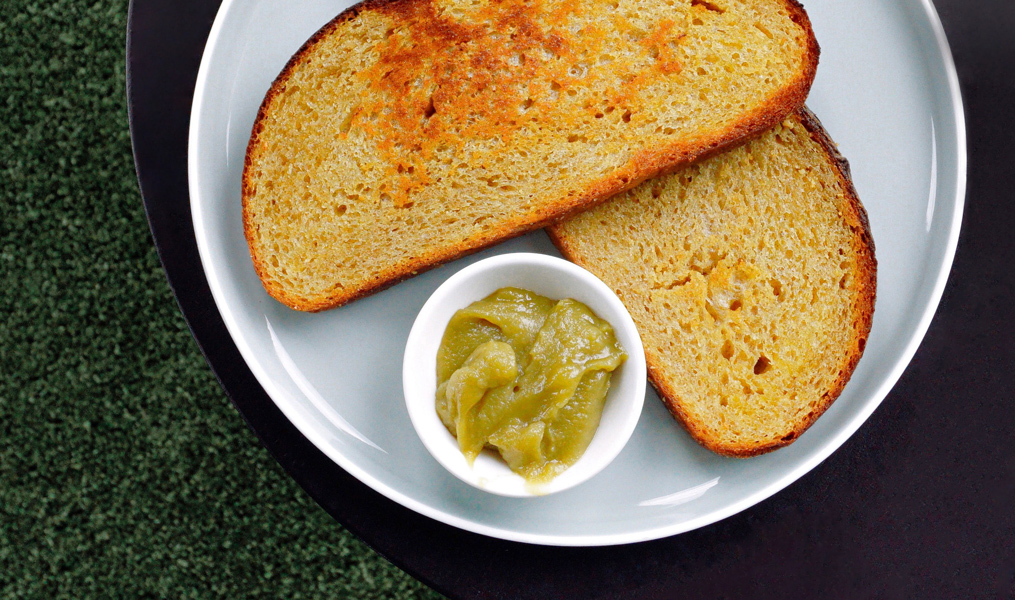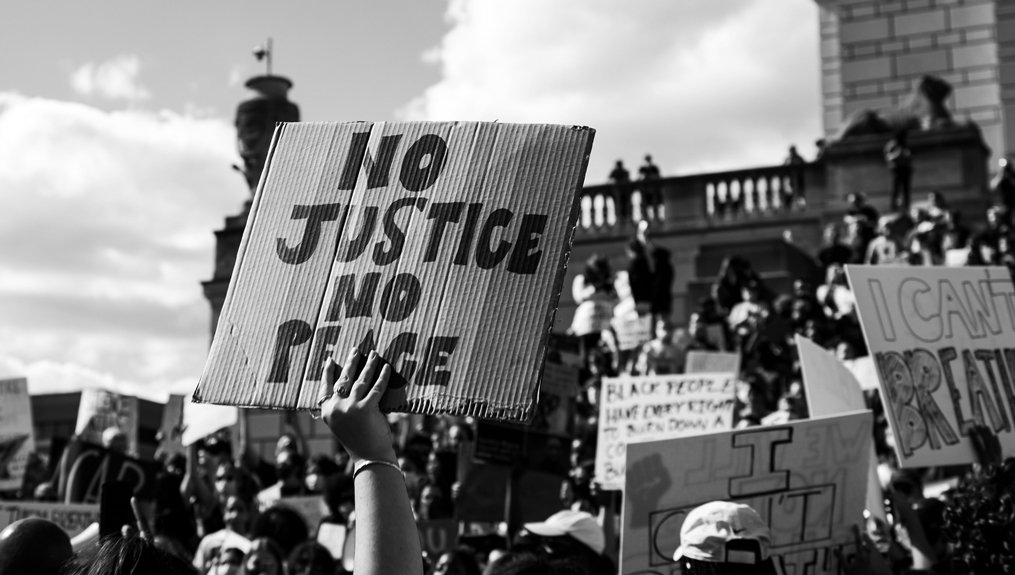KOPI GU YOU: brewed coffee with butter. Photo courtesy of Kopi House
Coffee culture in Southeast Asia
With the global rise of third-wave coffee in the last decade and a half, it’s natural that the focus of the industry has prioritized quality, purity, and provenance. We tend to evaluate a coffee based on its proximity to perfection—the perfect terroir, the perfect roast profile, the perfect brew recipe. Whole brands, competitions, and companies are built around arabica coffees, prizing their complexity and cup quality. We even go as far as to insist, as an industry standard, that coffee tastes best unsullied—so no cream, no milk, no sugar, please!
We’re also often under the (misguided) impression that specialty coffee, as we understand it, is a relatively young industry, with its roots in Antipodean coffee culture that then spread to other Western countries and took off in popularity. In fact, the spread of coffee across the world from its birthplace of the African continent centuries ago to the producing countries we know today, in order to supply coffee to developed consuming countries, is a modern dynamic deeply entrenched in colonialism. Governing bodies like the Specialty Coffee Association, World Coffee Research, and the Coffee Quality Institute, among others, espouse standards of evaluating coffee that are Eurocentric in nature, without necessarily taking into account the differences in experience, metrics of quality, and tasting backgrounds of coffee professionals the world over.
We thus run the risk of having a myopic view of what constitutes “good coffee,” according to an insular and homogenous experience. What does that mean, when coffee is as diverse a product as they come? What does that say about our ability—or lack thereof—to understand that while we have engineered standards and systems to objectively evaluate the quality of coffee, there is a far more nebulous factor at play: the subjectivity of experience, coupled with the context of occasion?
This is evident when we take into account the ways in which coffees have been lovingly interpreted and embraced by the cultures into which they were introduced, outside of the Western experience. I have the pleasure of interviewing Robert Chohan, founder of Kopi House U.K., dedicated to showcasing the diasporic Nanyang kopi heritage of Singapore in London, as well as Pamela Chng, cofounder of the Bettr Group in Singapore, a coffee organization dedicated to bettering the lives of women and marginalized youth in the country through vocational programs.
Coffee & Colonization
In order to understand how communities all over the world, and, in this instance, Singapore, came to have their own coffee cultures, it’s crucial to trace the spread of the crop via colonization.
“Early Singapurah [Singapore] and Southeast Asia in general has had much influence from European and Western powers throughout its history,” says Chohan. “The most notable influence comes from the Portuguese in the 16th Century, the Dutch in the 17th, and the British in the 18th.”
To maintain their supply of ready-to-drink caffeine, the Portuguese brought with them arabica coffee, which had been roasted and sugar-coated—known today as torrefacto roasting—to survive the long journey to Southeast Asia. The thin coating of sugar served the purpose of sealing the roasted bean, preventing oxidization that would turn them stale. Without any express shipping, their supplies would be expected to run low before new incoming shipments would arrive, especially with an ever-growing colonial community.
In Southeast Asia, the Dutch proceeded to introduce Arabica to Indonesia (then named Batavia) in the late 17th century, followed shortly by the French, who introduced Robusta to Vietnam, with the intention of implementing plantations where the cash crop would be grown with forced native labor.
Gradually, British colonization in Singapore (then named Malay Singapurah) and Myanmar similarly influenced coffee production within the region. There was also forced coffee production by the Spanish in the Philippines. Today, you will find varieties like Arabica, Robusta, Liberica (also called Barako), and Excelsa grown across the region, with Robusta being the predominant variety due to Southeast Asia’s equatorial terroir.
The Roots of Kopi
With the crop now established across Southeast Asia, it stands to reason that domestic consumption began to take root and evolve according to the regional practices and habits of people. Today, we’re talking about kopi (coffee) culture within Singapore—but what is kopi?
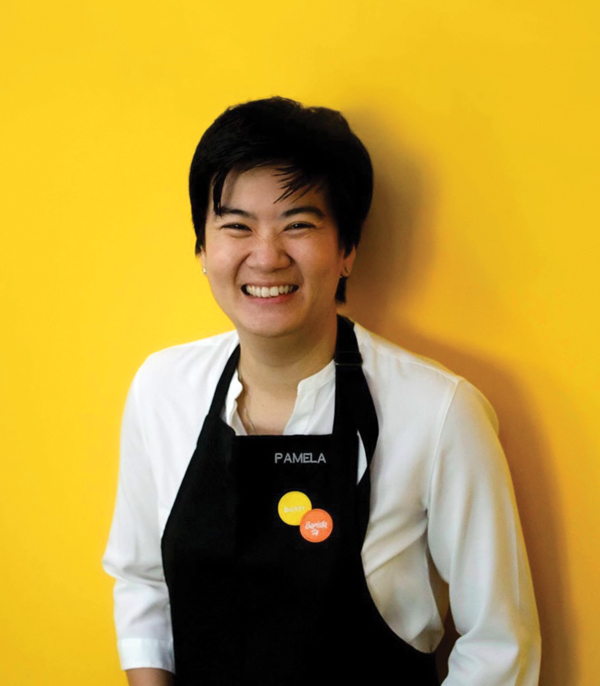
“Kopi is the heritage style of coffee made in Southeast Asia, with variations in each country,” says Chng.
While kopi may go by different monikers in different countries, the method of preparation is similar: brewed with a large sock filter and drunk black, with condensed or evaporated milk. Kopi can be prepared either hot or cold, all possessing very intense, bitter, heavy-bodied profiles, with little to no acidity.
“The simplest answer would be [that] kopi is the local traditional coffee of Singapore (and Malaysia), but this simply doesn’t do it justice,” adds Chohan. “With millions of drinkers in the region, it deserves better even though it is only found in the Southeast Asian region. Plus, there is also a small but noticeable difference between Malaysian and Singaporean Kopi.”
In Singapore, it’s usually found in hawker centers (a large, sprawling collection of open-air food and drink stalls) and kopitiams (coffee shops) all over the country. Ubiquitous and affordable, kopi is the drink of choice for a large population of the country, particularly the older demographic.
But how did such a drink come to be a staple in the hearts—and diets—of Singaporeans? Chohan thinks it started all those centuries ago, with the shortfall in supply of torrefacto arabica for the initial group of Portuguese settlers; the indigenous Malay population, seeing the opportunity to move the early Western colonizers from roasted arabica coffee to the local “lower-quality” robusta coffee, are credited with the invention of local kopi culture in Singapore.

“This took place in Singapurah and this is where [early] kopi has its origins,” he says. “The Portuguese loved this new style of coffee—different to their own, similar in some ways but just as delicious.”
The local Malays roasted the robusta coffee in large woks over a charcoal fire, and mimicked the torrefacto principle by caramelizing the intensely roasted coffee in molten sugar. They could not afford expensive European filters, so innovated by filtering the coffee grounds with a piece of cloth.
“This also produces an incredible and smooth mouthfeel, and even amongst some of the coffee community today it’s believed that cloth filters provide the best mouthfeel,” says Chohan.
And thus the earliest rendition of kopi was born, an amalgamation of the European love of coffee meeting the local Malay palate.
Kopi: A Melting Pot Beverage
While the Malays are considered the originators of kopi, the drink now proceeds to go through several evolutions as it begins to spread to different diasporas, including across the Straits of Johor into mainland Malaysia, with the country putting its own unique spin on the beverage. For example, Malaysian coffee is regularly roasted with salt, in addition to sugar, to boost the umami profile of the kopi; and certain places, such as the town of Ipoh, have chosen to deviate from traditional torrefacto roasting, instead including butter at the point of roasting.
They were also the first to add sweetened condensed milk to the bittersweet beverage, cleverly accounting for the humid tropical climate in which the storage and usage of fresh milk was not as viable as in colder climes, as well as boosting the mouthfeel of the drink. This “milk and sugar” practice then made its way back to Singapore, where it evolved into the kopi we know today, formally named Nanyang kopi.
The etymology of the beverage gives us clues as to the diverse and complex history of the drink upon reaching Singaporean shores: “Nanyang” literally means “Southern Ocean,” and is a Mandarin term referencing the warm lands of the South China Sea, an homage to the immigrants of Southern Chinese descent that arrived en masse in Malaysia and Singapore. “Kopi,” in turn, is Bahasa Melayu for “coffee,” and a nod to the enterprising indigenous Malays who are credited with creating torrefacto robusta all those centuries ago. Thus, “Nanyang kopi” is literally “Southern Ocean Coffee,” and its multicultural history is a culmination of the efforts of several key parties: the Malays, Teochews, Fujianese, Fuzhounese, and, perhaps most importantly, the Hainanese.
With the mass immigration of Southern Chinese populations, such as the wealthier Teochews, Fuzhounese, and Fujianese into Singapore around the time the British had colonized the country in 1819, there was an influx of trade in textiles, spices, and manual labor as these communities began to contribute to the local economy. By the time the Hainanese arrived, between 1850–1900, there were limited options as to economic expansion that the wealthier Chinese communities hadn’t capitalized on, so the Hainanese turned to a (then) underrated staple: coffee.
“The habit of drinking kopi arose in the early 20th century, with over 200 of these coffee shops—kopitiams—registered in Singapore in the 1920s,” says Chng.
These shops were set up primarily by the Hainanese, followed by the Fuzhounese. The Hainanese began as service workers for British colonial officers and families, and subsequently transferred their service skills and knowledge to opening Hainanese coffee shops for the local population.
They provided not only coffee, but food highly affordable for the local immigrant communities, such as the traditional “national breakfast” of half-boiled eggs, kaya (coconut jam), and butter toast, and a sweet, strong, and fragrant cup of kopi, along with other famous staples of Hainanese cuisine, such as chicken rice or pork chops. Kopitiams, adds Chohan, “are endearingly called Hainanese kopitiams today because of how affiliated the Hainanese are with this trade in Singapore.
“They continued to develop the roasting and brewing method [of kopi] and…along the way, the ‘piece of cloth’ turned into a formal coffee ‘sock’—a cloth filter sewn into a sock-type shape, with its open end attached to a metal hoop with a handle. This allowed it to be easily handled, and also put into the opening of a large pot into which brewed coffee complete with grounds would be poured,” he adds. “The sock would allow the brewed coffee to filter through and retain all the coffee grounds in a convenient-to-dispose-of way.”
Running the kopitiams on low profit margins meant the Hainanese had to develop more cost-effective ways to feed a rapidly growing population. The development of Nanyang kopi saw the addition of maize, as a bulking ingredient to lower the overall cost, and margarine, to help separate the sticky, caramelized beans as they cooled. Adding maize, paired with the intense sugar-roasting process, resulted in a distinctly robust and unique flavor—a happy accident that defined the tasting profile of an entire diasporic coffee culture.
Kopi Today
Today, kopitiams still use coffee processed in this manner. Over the years, blends containing different compositions of robusta, liberica, and arabica have been introduced for complexity and variety.
“All are considered ‘Nanyang kopi,’” says Chohan. “However, for many, particularly the older generation, Nanyang kopi is not Nanyang kopi unless the strong pungency of maize is part of the flavor. They are so accustomed to this from their youth that it is part of the drink.”
Nanyang kopi must be brewed in batches in order to attain the right concentration, and it must be filtered in a cotton cloth sock to create its iconic smooth mouthfeel. Unlike espresso, a brewed kopi “base” is almost always diluted to a more “drinkable” strength; the robusta concoction already contains a staggering amount of caffeine and sugars combined.
But arguably the most interesting part of drinking Nanyang kopi is the 132 configurations of the drink, constructed from the same kopi base. Ordering the drink you want from this dizzying array is as much a part of the experience as drinking the beverage itself, for Nanyang kopi has its very own lingo with which to articulate what you would like. It’s impossible to place the order in English, Mandarin, or any of the other main dialects. Kopi lingo is a creole—an amalgamation of the dialects of the ethnicities and cultures that were instrumental in making Nanyang kopi what it is today, primarily grounded in Hokkien and Malay. With such a code, most experienced kopitiam operators can whisk up your drink within 30 seconds.
“When you consider how complicated an order may be in a Western coffee shop…it may likely turn into a conversation and a long-winded description,” says Chohan. “With Nanyang kopi, considering it is churned out in unbelievable quantities, plus the need for a quick turnaround of clientele to keep the kopitiam business profitable, there is a highly structured process to place an order which is as much part of the Nanyang kopi experience as the coffee itself.”
The ordering format tends to follow the pattern: Coffee-Milk-Strength-Sweetness-Temperature.
“In a nutshell, you simply state you want kopi—which by default means you will receive coffee with condensed milk and two sugars,” he continues. “You can then add any additional modifying terms. If I said I want ‘Kopi-C Gao Siew Dai Peng,’ I am asking for a coffee, with evaporated milk instead of condensed milk; on the stronger side, with more brewed coffee and less water to dilute it; and less sugar (one sugar instead of two), and iced.”
The Fabric of a Diaspora
With such a rich and unique coffee culture, I was curious to know why kopi was so important, personally, to each of my interviewees, as well as the importance of kopi in the social fabric of diaspora.
“For Singaporeans, kopi is a collective memory,” says Chng. “The thick, bitter, yet smooth liquid can be enjoyed by everyone, regardless of age, social status, race.”
There is a quintessential image of an elderly uncle or aunty (an endearing term for older men and women) behind the counter, pulling a kopi tarik (the Malay word for “pull,” a technique in which the kopi brewer stretches and aerates the kopi by pouring it from a height) from the traditional sock filter, pouring a fast, steady stream through the long spout of the traditional kopi pot.
“Brewing an excellent cup of kopi requires trial and error of many generations,” says Chng. “It requires accuracy, practice, and dexterity to deftly handle the velocity of the liquid pouring out through the elongated spout of the stainless steel pot.
“The best time to drink it is in the early morning, in a traditional kopitiam,” she continues, “while listening and observing other customers chatting or reading the newspaper. This is the snapshot of daily life in Singapore/Malaysia, and kopi holds a collective memory for us. Many of our trainers recount tasting the bitter black liquid as toddlers in their grandparent’s lap, and hating that first experience. Yet they have come to encompass and share the importance of kopi as trainers.”
“I grew up in the U.K., so my first experience of kopi was in 2016 in Singapore,” says Chohan. “I did not know what Nanyang kopi was back then, and even when I had seen a few kopitiams I didn’t understand, nor appreciate, the importance of the ‘odd-looking’ coffee being sold there.
“It was only when I returned in 2016 that I decided to try it,” he says. “I was, quite simply, blown away by the strength and depth of flavor. I instantly fell in love with it.”
As a result of Chohan’s love of kopi, his awareness that the art of making the beverage is on the decline with younger generations preferring the trendier, Western-style specialty coffee scene, and kopi’s relative anonymity outside of Singapore and Southeast Asia in general, he decided to devote his life to promoting this beverage outside of its home country.
Kopi vs. Specialty: A Paradox?
It’s interesting to observe the dynamic between traditional kopi culture, so deeply embedded in the collective psyche of Singaporeans, and the newer, younger specialty coffee scene, with which Chng and Chohan are both involved. I was curious to know if they were able to reconcile their love for both distinct coffee styles.
“I really started getting into coffee in the mid-90s when I moved to Melbourne,” says Chng. “The coffee culture there was completely different and still very much in the Italian tradition. I missed my $2 cappuccinos when I returned to Singapore and could never quite find decent Italian-style renditions of coffee here.”
It was only when specialty coffee shops started popping up in Singapore around 2008 that she returned to specialty coffee, spending the next five years diving deep into all things specialty.
“I traveled the world learning about the specialty coffee industry, from brewing to cupping to roasting as we started up Bettr Barista,” she says. “I didn’t drink much kopi during this period as I became very sensitive to the bitter and earthy notes in kopi as I developed my sensory palate.
“It’s only been in the past three to four years that I reconnected with kopi and started to enjoy it for what it is, taking off the critical lens of specialty coffee quality standards,” she adds. “My tolerance has never been wider or more inclusive than at this point, as I recognize the characteristics of every quality of coffee for what it is and am able to enjoy both at the same time very easily now.”
With a firm eye on the systemic issues in the coffee value chain, Chng believes that coffee needs to be much less snobbish and exclusive—and being able to appreciate coffee in its myriad interpretations is a key component of accessibility and openness.
“We need to be more equal and inclusive across the entire chain if we want to be able to create more sustainable and equitable conditions for all segments of the coffee industry,” she says.
“Like many people who get into high-quality arabica, you often tend to go down a certain route,” agrees Chohan. “This is the problem with specialty coffee—your palate improves so much as you progress through the world of good coffee, that at some point you ruin it for yourself because you yearn for a higher-quality arabica every time.
“This is also what made Nanyang kopi so easy for me. It is a totally different world,” he adds. “With most blends being based primarily (or wholly) on robusta coffee, the ‘fussiness’ of a profile isn’t important. You do not need to worry about floral notes, or fruit notes, or milk chocolate notes. That is because those notes aren’t there to begin with, in robusta Nanyang kopi….You do not need to train your palate to pick out delicate flavors as you would do with speciality arabica coffee.”
Chohan bemoans the snobbery that he has encountered from Western-skilled baristas about Nanyang kopi, stating, “it is truly unbelievable. Simply because it is not the conventional espresso-style and because it’s Asian, it’s dismissed as being poor quality. The reality however is that those who do decide to sit down to try Nanyang kopi and approach it with an open mind, understanding it is outside the world of flat whites, or V60s, actually really like it.”
And perhaps the key isn’t to reconcile their approaches to both specialty and kopi, but rather simply to understand that these are two different products, to be enjoyed in entirely different contexts and occasions. Chohan is also keen to challenge the notion that Eurocentric standards of coffee are the yardstick by which we measure the quality of all coffees around the world.
“I am a lover of all things coffee, and I would like to believe I am open-minded enough to treat coffee cultures from around the world as distinctly different, so that one doesn’t influence my opinion of the other,” he says. “Sure, Western coffee places importance on the origin of a coffee, the altitude [at which] it’s grown, the varietal…and the only reason espresso-based coffee is popular the world over is because it’s Western, not because it’s incredible.” ”
The Best of Both Worlds
It is precisely that sentiment that drives both Chng and Chohan in the work they do today, to promote and preserve a vibrant diasporic coffee culture.
“The first and second waves of coffee transformed the colonial cash crop into a ubiquity in nearly every country. It’s important to preserve traditional diaspora coffee cultures—like kopitiams in Singapore—to keep brewing diversity within coffee,” says Chng. “Similarly, while the terms americano, latte, and French press are widely known, a sock-filter kopi would be harder to order at coffee shops outside of these diasporic coffee cultures, so it’s vital to preserve these practices and traditions.”
And sometimes the approach can simply lie in giving people a choice through exposure. Chng’s company, Bettr Barista, installed Singapore’s revolutionary first hybrid bar in their Facebook Singapore café in 2018, a setup which offered customers a choice between both specialty and local coffee.
“We trained our baristas in both [styles of coffee] and discovered that it was a great way for our young (16-year-olds) and old (55-year-olds) baristas to learn with and from each other,” she says. “We have since converted six of our bars into this hybrid format.”
In addition, Bettr Barista has also begun offering formal classes in which students can learn to brew traditional kopi.
“[This is] so that we can encourage more young people to pick up the skills and craft to ensure we preserve this precious heritage of ours right alongside specialty coffee,” says Chng. “We have the best of both worlds right here in Singapore—why not enjoy and celebrate it fully, much like how we celebrate our multicultural, multi-racial existence?”
Even though Nanyang kopi in its current form has been around less than a century, it has thoroughly defined Singaporean society.
“It is highly affordable…and also embodies the togetherness of society by offering a real food-and-socializing experience,” says Chohan.
But above all, he concludes that the best thing about kopi is that it’s distinctly Southeast Asian.
“This alone makes [kopi] worth preserving—it offers an alternative coffee world outside of the predominantly espresso-based market,” he says. “It embodies the effort of multiple ethnicities in producing what millions of people now drink as their daily hot beverage, and in doing so is a reminder of the journeys of those people when they arrived in Singapore.”



